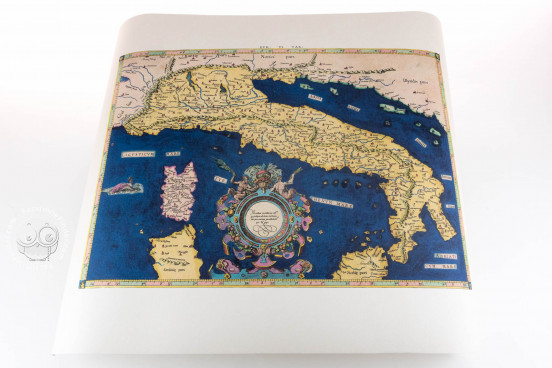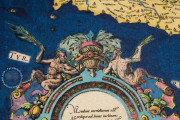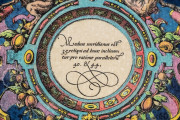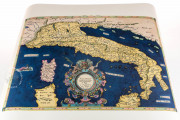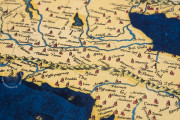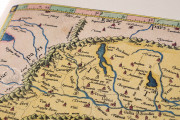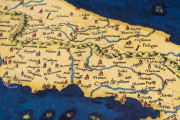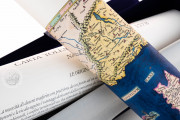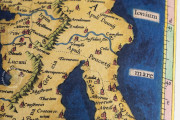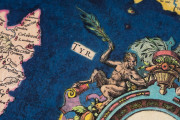This engraving of the Ptolemaic Map of Italy was prepared for the Flemish cartographer Gerhard Mercator's Tabulae geographicae Cl. Ptolemaei (Geographic Maps according to Claudius Ptolemy), first published in Cologne in 1578. The hand-coloring of this example lends it an artistic quality equal to Mercator's intellectual aspirations for his work. The coloring in vivid blues, ocher, and pinkish-lilac is exquisitely applied—almost certainly the work of a professional.
Mercator's aim was to reproduce faithfully the content of the Geography of the ancient Roman scientist Ptolemy (second century CE), the most thorough discussion of the geographic knowledge of the Greco-Roman world.
The Ancient World View
The engraving reflects Ptolemy's worldview. The escutcheon reports that the map shows the portion of the world between forty and forty-five degrees latitude and at thirty-five degrees longitude following Ptolemy's placement of the meridian at the Fortunate Islands, the westernmost land known to the Romans. The Ptolemaic coordinates are indicated along the edges of the map, which embraces a larger area than that implied by the text.
Mountains, Rivers, and Settlements
The map records topography in the form of mountain ranges: prominent are the Apennines running most of the length of the Italian peninsula and the Alps. Aetna is shown on Sicily, and the mountains of Corsica and Sardinia are also indicated. The courses of rivers are carefully plotted, and towns and cities are indicated by a circle and a tower icon. Labels abound, and regions are divided by dotted lines.
Decorative Flair
This first version of Mercator's Ptolemaic Map of Italy is distinguished from the engraving used after 1584 by the elaborate escutcheon, embellished with fictive sculptural elements including fruit and floral motifs. A pair of satyrs, holding palm fronds, are pictured from front and back twisting to confront one another. A giant sea turtle is represented near the left edge of the map in the Ligurian Sea.
Finesse and Restraint
The engraving's colorist sensitively applied a limited palette in elevating the aesthetic quality of the map. The deep and brilliant blue of the sea immediately captures the viewer's attention, and the lighter colors are applied with great delicacy, often enhancing the three-dimensional illusions suggested by the underlying engraving. The colorist probably worked after Corsica gained its independence from Genoa in 1755, since the island's coastline does not share the ocher color of the Italian coasts.
Enduring Interest
Although this engraving was originally produced in connection with Mercator's publication of 1578 (with a second edition in 1584 reusing the same plate), this particular example of the map was inserted into a copy of Italia by Giovanni Antonio Magini, published posthumously by Giovanni's son in 1620. Although Italia itself is dominated by maps reflecting contemporary geographic knowledge, it includes a version of the Ptolemaic map of Italy very similar to, and probably copied from, that of Mercator. The historical value of Ptolemy's view, therefore, continued to be appreciated, and the map is represented twice in this extra-illustrated copy of Magini's book.
We have 1 facsimile edition of the manuscript "Ptolemaic Map of Italy": Carta Tolemaica dell'Italia di Gerardo Mercatore facsimile edition, published by Priuli & Verlucca, editori, 2004
Request Info / Price
